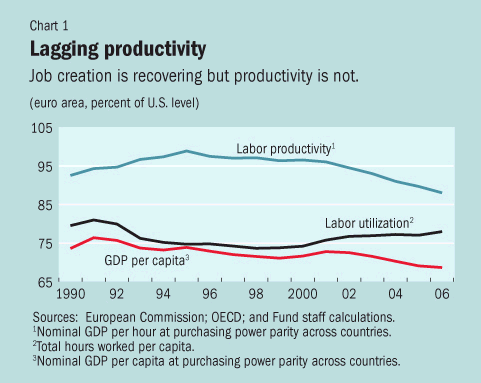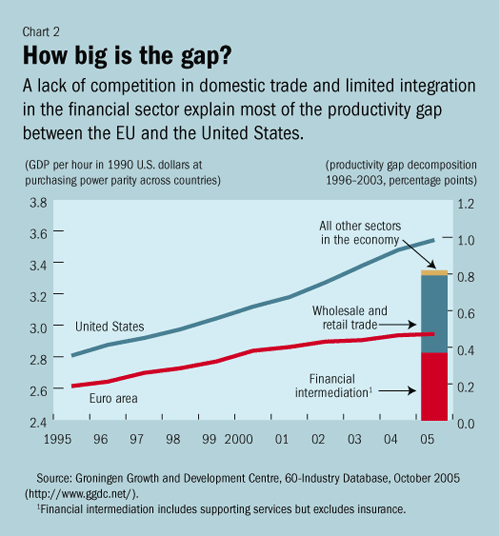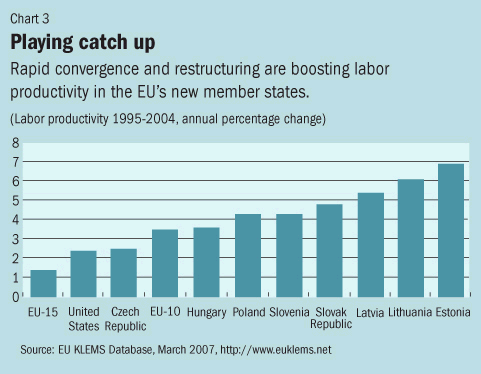
Typical street scene in Santa Ana, El Salvador. (Photo: iStock)
IMF Survey: Making Europe's Good Times Last
June 13, 2007
- Economic outlook for Europe is brightest of current decade
- Policymakers should seize opportunity to adopt reforms that will raise productivity
- New members' challenge: keep catching up with living standards in West
With a strong recovery under way in most of western Europe and with eastern and central Europe rapidly catching up with the living standards of its richer neighbors, confidence in the 27-member European Union (EU) is high.

Electrical cable plant in Germany, where firms have gained efficiency through outsourcing (photo: Daniel Karmann/DPA)
EUROPEAN UNION'S NEW MEMBERS
After years in the doldrums, Europe's largest economy, Germany, is showing impressive growth, leading many observers to conclude the country has finally completed its adjustment to unification with eastern Germany in 1990. With a new government in France, there is a sense of renewed optimism about growth-enhancing reforms there as well.
In most of central and eastern Europe, home to the EU's newest member states, growth is strong—some economies, in fact, are in danger of overheating. Will the good times last for Europe this time around? Much will depend on the continent's ability to stay competitive in the global economy.
Speaking at a May 23 conference in Estonia on opportunities for Europe's economy, IMF Deputy Managing Director Murilo Portugal said he had confidence in the EU's ability to respond to global competitive pressures. "But renewed momentum in economic and financial integration will be needed if Europe is to continue to deliver the inclusive prosperity it is being admired for around the globe," Portugal said.
Time for reforms
This sentiment was echoed by Michael Deppler, Director of the IMF's European Department. At a June 5 press conference on economic prospects for the euro area, he noted that while Europe is currently doing very well, now is the time for policymakers to adopt the reforms that will raise productivity and secure the foundation for continued, solid growth.
Although the EU has fallen short of achieving its own ambitious employment targets, job creation in Europe has in fact exceeded that in the United States since 2000. Following the successful turnaround of labor utilization, most advanced economies in the EU now need to set their sights on achieving a similar improvement in labor productivity (see Chart 1).

A sectoral breakdown of the rising productivity gap with the United States shows that Europe's problem lies with the service sector. Whereas Europe is strongly positioned in manufacturing, services have long enjoyed protection from competitive pressures in most of the EU's member states. As a result, this sector has yet to benefit from full integration within the EU (see Chart 2).

Completing EU's single market
What is needed, Portugal said, is a more comprehensive reform strategy that exploits synergies across labor and product market reforms, as demonstrated by Europe's most successful performers, a group that includes the Nordic countries, the Netherlands, and the United Kingdom. What these countries have in common is an openness to the rest of the world, a tendency to favor market forces over regulation, and a demonstrated willingness to reform their labor markets and welfare systems in response to pressures from aging and global competition.
These policies have paid clear dividends. Welfare reforms have encouraged more people to join the labor force, and measures to liberalize product and services markets have strengthened the demand for labor.
These countries' experiences tell us is that embracing the EU's single market can give a tremendous boost to competitiveness. Achieving a truly seamless single market for both goods and services is where the interests of the EU's older member states most clearly coincide with those of the new member states.
Older member states stand to benefit in terms of improving their ability to compete in the global economy. For example, studies show that German firms have become more efficient by outsourcing part of their production to eastern Europe, reimporting the products as intermediate goods, and then exporting the final goods to the rest of the world.
In turn, the new member states benefit from the transfer of know-how embedded in foreign direct investment. They also gain access to other sources of finance that they can use to speed up income convergence, thereby achieving significant welfare gains (see related article on capital flows).
Rapid income convergence
The EU's new member states are rapidly catching up with living standards in western Europe. Most countries are growing at least twice as fast as the euro area, and a few are even enjoying double-digit growth rates. Labor productivity growth in the new member states is also in a very different league from that in the older member states (see Chart 3).

A prime example is Estonia, whose highly integrated financial sector has become a leading contributor to growth. Catching up has so far been smooth but speed limits are no doubt being tested and the easy gains may well be nearing exhaustion. Hence, if the new member states want to stay on top of the game, they will need deeper reforms (see related article on competitiveness).
New member states must tackle the remaining structural rigidities in their economies if they want to enjoy a balanced catching-up process. They can help secure economic stability by further strengthening their macroeconomic policies and by ensuring strong prudential oversight of the financial sector.
More flexible labor markets, more competitive product markets, and deeper financial markets will foster productivity gains and deliver the returns that investors are anticipating. Specific reform agendas will, of course, need to be tailored to country circumstances (for examples, see related articles on Slovenia and Romania).
Euro adoption
Adoption of the euro offers the new member states the opportunity to further enhance their prospects for growth and reduce the risks associated with rapid income convergence. While structural reforms are needed to improve competitiveness, sound macroeconomic policies are essential to maintain economic stability.
Given the buoyant outlook for most countries in central and eastern Europe, a further gradual tightening of monetary policy seems warranted at this point, at least in those countries that still have an independent monetary policy. More importantly, strong fiscal policies will remain essential.
For all the new member states, a balanced budget, and even a surplus, should be the goal. For countries where budget deficits are still large (a group that includes the Czech Republic, Hungary, Poland, and the Slovak Republic), fiscal restraint would provide more room for the private sector to blossom. For countries experiencing very rapid growth (a group that includes the three Baltic countries, Romania, the Slovak Republic, and Slovenia) fiscal tightening would help reduce wage pressures and safeguard competitiveness.
In sum, the new member states would do themselves a favor and encourage a smooth catching-up process with the living standards enjoyed by their richer neighbors if they pursue the type of policies that are needed to adopt the euro.


